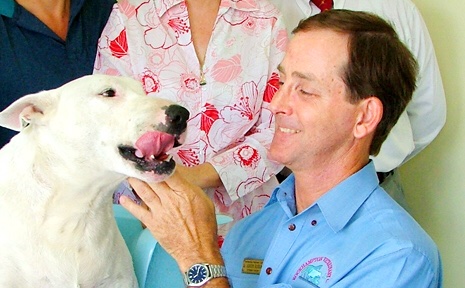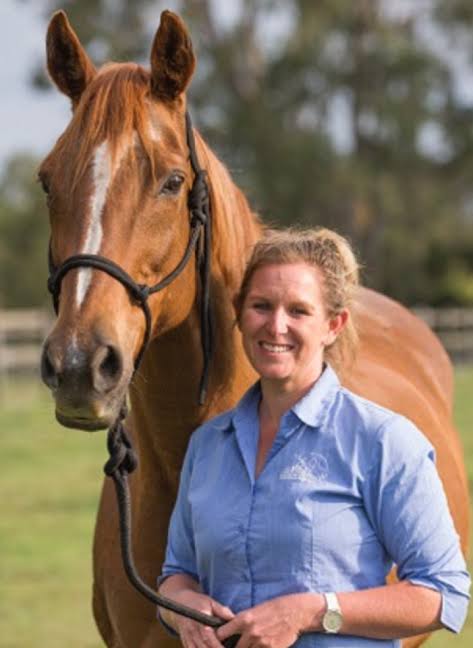you guys know about the Hendra virus right? it’s a bat disease named for the suburb of Brisbane where it was first discovered in humans. mostly white men and look, I don’t wish to be rude about the dead, but they don’t look like very adventurous eaters #tab=tab_1">https://www.who.int/health-topics/hendra-virus-disease #tab=tab_1">https://www.who.int/health-to...
Hendra virus is endemic in flying fox (fruit bat) populations on the East Coast of Australia. There are no recorded cases of direct transmission from bat to human; the virus passes from bat to horse (likely via food contamination) and horse to human.
Some bats are roosting near your stable, some bat shit gets in the horse feed, the horse gets sick with a bat disease, and the horse gives the disease to the vets and trainers trying to treat her. This is just happens sometimes when you keep domestic animals near wild ones.
This is Victor “Vic” Rail, the first known human to die of Hendra virus. He grew up around horses in Townsville, working as a jockey and later horse trainer. In 1994 he contracted the virus via his horses, who had likely sniffed or eaten leaves with infected bat urine on them.
Here’s a picture of Vic Rail with one of his horses as a younger man. Is this the type of person you think of when you think of initial vectors for bat diseases making their way into human communities? If not, why not?
You can read about his life here: http://adb.anu.edu.au/biography/rail-victory-robert-vic-27840">https://adb.anu.edu.au/biography...
You can read about his life here: http://adb.anu.edu.au/biography/rail-victory-robert-vic-27840">https://adb.anu.edu.au/biography...
This is Dr Ben Cunneen, a Queensland horse vet who died of Hendra virus in 2008. He was in intensive care for a month before he died. He was 33. https://mobile.abc.net.au/news/2008-08-21/qld-vet-dies-of-hendra-virus/484684?pfmredir=sm">https://mobile.abc.net.au/news/2008...
This is Ben’s wife Gillian Cunneen with their daughter, Jemma. Jemma has never met her father; Gillian first discovered she was pregnant with Jemma as Ben was dying in hospital. Jemma was born on their wedding anniversary. https://amp.brisbanetimes.com.au/national/queensland/grieving-widow-feels-hendra-pain-20090816-emfh.html">https://amp.brisbanetimes.com.au/national/...
This is Rockhampton vet Dr Alister Rogers. For many years he was known as “the flying vet” because he flew a small plane to provide vet care to remote farms. He died of Hendra virus in 2009 after treating an infected horse.
You can read the eulogy delivered by Alister’s father, in which he calls for more caution around bat-to-horse viral transmission, here: https://m.themorningbulletin.com.au/news/alister-rodgers-was-no-nonsense-vet/357858/">https://m.themorningbulletin.com.au/news/alis...
In 1995 Mackay sugarcane farmer died of Hendra virus after unknowingly having the disease for a year. It was only after his death that the virus was traced back to two of his horses. I couldn’t find a picture of Mark but you can read about him here: https://mobile.abc.net.au/news/2009-08-11/hendra-virus---fact-box/1387192">https://mobile.abc.net.au/news/2009...
Natalie Boehm, a 21-year-old vet nurse, worked at the same practice as Ben Cunneen in 2008. She also became ill with Hendra virus, but survived. She experiences long-term chronic illness as a result of the virus. https://www.abc.net.au/radionational/programs/archived/bushtelegraph/hendra/4820336">https://www.abc.net.au/radionati...
Hendra virus is extremely deadly: 4 out of the 7 humans who have developed the disease, and 70% of horses, have died. The disease has not so far been shown to be transmissible from human to human, or bat to human; everyone who has been infected worked closely with horses.
However, it’s this kind of continual contact between species that leads to a virus mutating and becoming transmissible between humans. There’s nothing dramatic or memorable or strange about it, it’s just a side-effect of living in a world with other animals.
I hope that I’ve given you a sense of the lives of the people who’ve died or suffered because of the Hendra virus. I felt very sad reading about them. It’s an awful way to die and none of them were ready to go.
It makes me really sad to see people talk about the first people to COVID-19 as if they weren’t even people, just disease vectors. A lot of people have seized on the belief that the disease initially came from bats and used it to blame and mock the first victims.
I don’t think it matters how, exactly, the initial transmission happened. Even if it was through eating bats — which is unlikely — I think it’s horrible to blame people who got sick, and stupid to act as if that’s a uniquely foolish choice when bird flu and swine flu exist.
I’m seeing a lot of white people in particular being very quick to blame Chinese people or Chinese culture or something else they believe is unique to China for the emergence of COVID-19. But white, rural Australians can also get bat diseases.
I hope that we can have the same compassion for anyone sick with a new and strange and terrifying disease. I hope we are all smart enough to know the next pandemic could come from anywhere.
More information about Hendra virus: http://conditions.health.qld.gov.au/HealthCondition/condition/14/217/363/hendra-virus-infection">https://conditions.health.qld.gov.au/HealthCon...
https://www.health.nsw.gov.au/Infectious/controlguideline/Pages/hendra-case-summary.aspx">https://www.health.nsw.gov.au/Infectiou...
2019 https://amp.abc.net.au/article/11204932">https://amp.abc.net.au/article/1...
https://mobile.abc.net.au/news/2011-09-12/hendra-virus-explained/2881140">https://mobile.abc.net.au/news/2011...
https://www.abc.net.au/news/topic/hendra-virus-infection">https://www.abc.net.au/news/topi...
PS: The Hendra virus gets more attention because it’s more lethal, but there is also another Australian bat virus of note! Australian Bat Lyssavirus is transmissible directly from bats to humans via untreated bite/scratches. More info: http://conditions.health.qld.gov.au/HealthCondition/condition/14/217/10/australian-bat-lyssavirus">https://conditions.health.qld.gov.au/HealthCon...
There are many bat-borne viruses that have been known to infect humans either directly or via infection of a domestic animal. The reason is almost always increased contact between humans and bats due to urban expansion and bat habitat loss. Here’s a list: https://en.m.wikipedia.org/wiki/Bat-borne_virus">https://en.m.wikipedia.org/wiki/Bat-...
There is a real public health issue behind bat viruses spreading to humans, it’s not just bad luck. But it’s a problem many many countries are facing — rapid urban expansion and destruction of bat habitats forcing bats to live much closer to humans than they’d like.
Melbourne has had a huge flying fox colony (6,000-20,000 bats depending on season) within city limits since the 80s when they moved south following habitat loss! https://wildlife.vic.gov.au/our-wildlife/flying-foxes/victorias-flying-fox-colonies">https://wildlife.vic.gov.au/our-wildl...

 Read on Twitter
Read on Twitter








